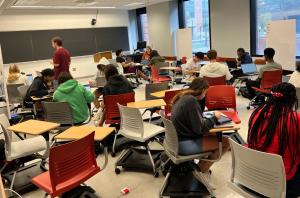
College of Arts and Sciences (ASC) received the Driving Change grant through the Howard Hughes Medical Institute (HHMI), which helps universities create more inclusive learning environments for students in STEM (science, technology, engineering and mathematics) courses. As part of this effort, ASC is transitioning foundational STEM courses from large lectures to smaller sections incorporating active learning and strategies for inclusive teaching to improve retention of students in STEM.
The Classroom Readiness Committee, which the Learning and Collaborative Environments team is a member, has partnered with the College of Arts and Sciences (ASC) on this pilot through renovation of six pool classrooms on the first floor of McPherson Lab.
“The initial idea for the spaces was to transition from a traditional lecture approach to a distributed classroom model and leveraging active learning strategies,” says Katelyn McDonald, Space Design Strategist. “The intent in this model is to break classes into smaller groups, have the instructor share content using Zoom, or through recorded content, with TAs in each room to host and facilitate group work where students have the opportunity to engage in a smaller setting.”
They piloted the spaces this fall, made updates for spring semester, and will further enhance this summer to incorporate feedback from faculty using the spaces last term. Initially refreshing the rooms to enable active learning involved bringing in mobile furniture to support easy reconfiguration of the space: student chairs with large writing surface for group work , a height-adjustable table for the instructor, and whiteboards for group activities. Enhancements planned for this summer include more displays, a variety of chair colors to assist with breakouts, more whiteboards, and new carpet, paint and lighting.
The Classroom Readiness Committee is a collaborative team that oversees the strategy and planning for classroom pool. Their goal is to design quality spaces that support best practices in teaching and learning. In addition to the Learning and Collaborative Environments team, the Classroom Readiness Committee includes partners from the Drake Institute for Teaching and Learning, Facilities Operations and Development and Design and Construction, Office of the Registrar, and Planning, Architecture and Real Estate.